 Print ISSN 2010-3484
Electronic ISSN 2010-3492 |
|
|
|
|
|
|
|
|
|
|
|
|
|
|
|
|
|
|
|
|
|
|
|
|
|
|
|
|
|

|
|||||||
| Srinivasa Ramanujan — from Kumbakonam to Cambridge |
| K. Srinivasa Rao |
|
Introduction Srinivasa Ramanujan has been hailed as a natural mathematical genius and compared to all time great mathematicians Euler and Gauss, by his friend, philosopher and guide, G H Hardy. In 1940, Hardy gave two lectures at Yale University, which were subsequently published as a book [1] entitled: "Ramanujan: Twelve Lectures inspired by his life and work". Earlier, in 1927, Hardy, along with Dewan Bahadur Ramachandra Rao and P V Seshu Iyer, brought out the "Collected papers of Srinivasa Ramanujan", which have been more recently reprinted [2], in 1999, by the American Mathematical Society and the London Mathematical Society.
Unfortunately, for about half of the duration of his sojourn in England, Ramanujan was in and out of Sanatoria, and wrongly diagnosed and treated for tuberculosis (TB). In 1919, when Ramanujan was ill, Hardy spoke to Sir Arthur Eddington, who was the Chairman of the Royal Society, London then, to make Ramanujan a Fellow of the Royal Society (FRS), which Hardy felt would act as a stimulus for further research by Ramanujan. Eddington was by then, May 1919, a celebrity, as a consequence of his successful expedition to South Africa, to observe the bending of light during a total Solar eclipse, confirming the predicted angle of deviation by Albert Einstein and hence of Einstein's General Theory of Relativity. When Eddington asked Hardy whether Ramanujan could wait for the FRS to be awarded to him one year later, Hardy told Eddington that Ramanujan may not be at Cambridge since he was contemplating to send him back to India, whose warmer climate, he thought, would restore Ramanujan's health and spirits. So, on February 28, 1919, Ramanujan was elected Fellow of the Royal Society. In India, February 28, is celebrated as "Science Day", due to the discovery and announcement of the Raman Effect by Sir C V Raman on February 28, 1928. It would be fitting if it is also recognised as the day on which Ramanujan became a Fellow of the Royal Society — the first Indian mathematician to become a FRS Professor. G H Hardy sent a telegram to Mr Dewsbury, Registrar of the Madras University, announcing the award of this distinction, on that day.
Birth and Schooling Ramanujan was born on December 22, 1887, to Komalathammal and K Srinivasa Iyengar, a "gumastha" or clerk to a cloth merchant in Kumbakonam, at his mother's residence in Erode. It was a Thursday, and since the religious leader Ramanujachariar was born on a Thursday, as in most Iyengar families, the choice of the name for the new born was Ramanujan. As in one of the conventions, his father's name Srinivasa became the surname and his name Ramanujan (S Ramanujan). He was the first of 3 sons and was sent to the Kangeyan Primary School, in Kumbakonam — a school no longer in existence today. In November 1897, he stood first in the Tanjore District Primary Examinations, and this entitled him to a half-fee concession in the Town High School, Kumbakonam, where he had his schooling, from 1898 to 1903. He passed the Matriculation Examination of the University of Madras, in December 1903. The academic year in the days of the British Raj was from January to December, to enable the Britishers to plan holidays with their families at the time of Christmas and the dawn of the New Year.
Ramanujan's mother used to go regularly to the Sarangapani temple to be one of the lead singers in the Bhajans. This is possibly because at the end of the group singing, "prasaadam" (food offered to the God) would be distributed to all present. Occasionally this was the meal for her first born Ramanujan, since the meager earning of about Rs 25-30 per month, by his father, as a clerk ("gumastha") to a cloth merchant, was inadequate to make both ends meet for the growing family of Srinivasa Iyengar and Komalathammal! School Anecdotes
Ramanujan was also entrusted the responsibility of preparing the conflict-free time-table for the Town High School, which had at that time about 1400 students. This was a task entrusted to the senior mathematics teacher of the school, Mr Ganapathy Subbaier, who had confidence in the abilities of Ramanujan in doing this job. With hindsight, we can draw the conclusion that the work of Ramanujan on Magic squares started at about this time. Magic Squares
One can form also 4 x 4 (Date) magic squares and higher dimensional magic squares. Only Chapter 1 of his first Notebook has a title: "Magic Squares", all other chapters in his Notebooks are untitled. Chapter 1 of his first Notebook has 3 pages devoted to this topic and Chapter 1 of his second Notebook, has 8 pages, with 43 entries. While his first Notebook has 16 chapters and 134 pages, his second Notebook has 21 chapters and 252 pages. So, experts consider the second Notebook a revised, lengthened version of the first Notebook. Turning the second Notebook around, Ramanujan wrote down some more entries in an unorganised manner (unlike in his well-organised first and second Notebooks) and this is considered as his third Notebook which has 33 pages, containing about 600 theorems and proofs are being provided in an ongoing project by Bruce Berndt and George Andrews. Again, in retrospect, we may conjecture that magic squares is perhaps his first introduction to partitions of integers. For, can we not say that he is looking at the partitions of 15 in 3 parts and the problem is equivalent to solving a set of equations, which is a consequence of: a + b + c = d + e + f = g + h + i = a + d + g = b + e + h = g + h + i = a + e + i = c + e + g = 15? An admirer and friend of Ramanujan took him to see his Uncle, Dewan Bahadur Ramachandra Rao, who was the Collector of Nellore, stationed at Tirukkoilur. On the first 4 occasions, they were unable to meet the Collector, and it was only on the fifth occasion that they met him. Although Ramachandra Rao was initrally highly skeptical about the prowess of Ramanujan, when he saw the mathematical entries in Ramanujan's 2 thick Notebooks, he could neither make head or tail of the gamut of notes/entries he saw in them. Note that Ramachandra Rao considered himself very knowledgeable as compared to a school boy as he was a MA in mathematics. Precocious at School Ramanujan won prizes in School for proficiency in English and in Mathematics. S L Loney's "Trigonometry" was a prize book for him in his Form IV at School and he mastered this book. He also won prizes in Form II and Form VI. In 1905, Ramanujan joined the Government Arts College's Intermediate class in his first year. However, after a few months, he stopped going to the college, probably because he found the classes uninteresting. His own productive period in mathematics also started with his jotting down of mathematical results in his Notebooks, during those 5 years between 1905 and 1909, when there is scant amount of information about his activities. It is known that he even went to Visakhapatnam, perhaps in search of tuitions to eke out a livelihood, for a brief period without informing his family. His first publication was a 15-page-article on "Some properties of Bernoulli Numbers" which appeared in the Journal of the Indian Mathematical Society (JIMS), in which his earliest contributions were in the form of Questions or Answers to Questions that had appeared. In his illustrious career, Ramanujan proposed in all 59 Questions or Answers to Questions in the JIMS. As Ramanujan was in Triplicane, he was close to the Parthasarathy Temple, which he frequented and more importantly, was where he came into contact with S Narayana Iyer, MA (Mathematics), Manager of Madras Port Trust, whose residence was close to Ramanujan's. In fact, it was Narayana Iyer who discovered the talent in Ramanujan and brought him into contact with the right people at the right time. He was a pillar of strength for Ramanujan, not only throughout Ramanujan's lifetime but also even after his death. Narayana Iyer and his wife helped Janaki Ramanujan, Ramanujan's wife, in every possible way. From the 75th Birth Anniversary of Ramanujan, in 1962, when the Government of India issued a stamp to mark the occasion, Janaki started getting recognition as the wife of the mathematician who impressed everyone with whom he came into contact with, be it Narayana Iyer, Ramaswamy Iyer, Ramachandra Rao, Seshu Iyer, Sir Francis Spring, G T Walker, E H Neville, or G H Hardy. It is the orchestrated efforts of these great human beings, which were responsible for Ramanujan getting all the recognition which he richly deserved — the financial support required for his visit to and stay in England, the BA Degree of the Cambridge University, the Fellowship of the Royal Society, the Trinity College Fellowship, and for tirelessly disseminating his name, fame and achievements, to all concerned. Ramanujan, who failed in his FA degree examinations of the University of Madras in 1905 and again in 1907, became the first Indian mathematician to be awarded the FRS. He was at Cambridge for 5 years, before he returned to India, “only to die", as Janakiammal regretted soon after Ramanujan died on April 26, 1920. Janaki Ramanujan lived for ~74 years after the death of Ramanujan, till she passed away, on April 13, 1994. Ramanujan's paper in the Quarterly Journal of Mathematics 45 (1914) 350-372 entitled "Modular equations and approximations to p" contained 19 infinite series formulae for 1/p, one of which he asserted would be "rapidly convergent". Only in 1984, Borwein and Borwein used a modified version of Ramanujan's formula to compute p to 17 million places and found that the formula converges on the exact value with far greater efficiency than any other, thereby proving that the intuition of Ramanujan was correct as usual. Glimpses into His Work In a short article like this one, meant for students of Mathematics, it is relevant to give an elementary mathematics result and a number theoretic result of Ramanujan, to make the reader realise why the world of mathematics remembers him today and why several Departments and an Institute have been named after him. This article will be concluded with a selected entry for nested roots of Ramanujan [5]:
Another elementary number theoretic problem is the Diophantine equation: x2 + 7 = 2n, for which Ramanujan conjectured that the solutions are: x = 1, n = 3; x = 3, n = 4; x = 5, n = 5; x = 11, n = 7; and x = 181, n = 15. It was only in 1948, nearly three decades after Ramanujan died, on April 26, 1920, that Nagel proved that there are only five solutions and no more exists other than those given by Ramanujan. Did Ramanujan know that this was the case? The fact that he never provided proofs for his entries in his Notebooks but could provide more than one when anyone asked for a proof for any entry, makes one conjecture that he perhaps knew that these were the only solutions but left it as a teaser, as most of his entries were, for posterity to ponder and provide proofs (which in some cases required mathematics developed after Ramanujan's times). In general, Ramanujan is one of the all time great mathematicians and belongs to the class of Euler and Gauss, as stated at the beginning of this article. Interested readers may refer to Robert Kanigel's biography [5] and the biographies written by the present author [6, 7], which also contain glimpses into his mathematics. Finally, mathematics students whose interests have been kindled by this short article, may refer to the comprehensive five volume work of Bruce C Berndt [8], who spent 22 years of his life to provide a proof for each one of the 3254 Entries of Ramanujan in his Notebooks. It would be incomplete if attention is not drawn to the story of the discovery [9] of the “Lost" Notebook of Ramanujan, discovered in the Spring of 1976, when Professor George E Andrews of the Pennsylvania State University was going through the estate of G N Watson and came across about 100 loose sheets of paper in which more than 600 Entries were written in scrawling handwriting, uncharacteristic of Ramanujan. Bruce C Berndt, George E Andrews are bringing out another series of volumes providing proofs for the Entries in this "Lost" Notebook which contain some of the most intriguing work of Ramanujan which has laid the foundation for what he christened as "mock" theta functions. In Fig. 19, a recently constructed statue of Ramanujan in the foyer of the Coding Theory Institute, SETS, in the Ramanujan IT City, Taramani, Chennai is shown. The photograph of Ramanujan seated, after he was awarded the BA degree by research of the Cambridge University, modified with the later day passport (face) photograph of Ramanujan has been sculpted by K G Ravi, and installed in June 2010. The 4-sided pedestal of the statue has the following inscriptions on the sides (anti-clockwise): Srinivasa Ramanujan (December 22, 1887-April 26, 1920); π = 3+1/(7+1/(15 +1/(1 +1/(298+1/(1+...)))); Tau conjecture: |r(p)| ≤ 2p11/2; Taxi cab number: 13+123 = 1729 = 103+93. Publication Record
The friends (Fig. 17) are (L to R): K Ananda Rao, S S Suryanarayana, T Suryanayana and Adinaryana Chetty, identified by V Viswananthan for Bruce C Berndt, who brought out the book "Ramanujan: Letters and Commentary", with Robert A Rankin, AMS-LMS (1995) and its Indian edition by Affiliated East West Press Private Limited (1997). The statue of Ramanujan sculpted by K G Ravi was installed at the entrance of the Operational Head Quarters of the Society for Electronic Transactions and Security (SETS), Taramani, Chennai 600113, India, in June 2010.
|
| Copyright© 2023 World Scientific Publishing Co Pte Ltd • Privacy Policy |

 This reprinting of the two volumes at the dawn of this century clearly is an indication of the intrinsic worth of the work of Ramanujan in his brief life span of 32 years, 4 months and 4 days, of which he spent five years, 1914-919, at the Trinity College, Cambridge University. Hardy convinced the authorities to award to Ramanujan the BA degree, by research, of the Cambridge University, for his contributions to mathematics, including his longest paper [2] on "Highly Composite Numbers", which Hardy considered was in the "scientific backwaters", of mathematics of the times, but was unique as far as its originality and Ramanujan's creativity in mathematics are concerned.
This reprinting of the two volumes at the dawn of this century clearly is an indication of the intrinsic worth of the work of Ramanujan in his brief life span of 32 years, 4 months and 4 days, of which he spent five years, 1914-919, at the Trinity College, Cambridge University. Hardy convinced the authorities to award to Ramanujan the BA degree, by research, of the Cambridge University, for his contributions to mathematics, including his longest paper [2] on "Highly Composite Numbers", which Hardy considered was in the "scientific backwaters", of mathematics of the times, but was unique as far as its originality and Ramanujan's creativity in mathematics are concerned.
 Mainly due to the efforts of Professor Robert A Rankin, a renowned mathematician and Dr D A B Young, a medical doctor [3], it is now common knowledge, amongst the admirers of Ramanujan, that the cause of the death of Ramanujan was not the then dreaded TB, but hepatic amoebiasis, which was the cause of his illness twice in his younger days, in India. Since TB was diagnosed, in 1919, by doctors in England and in India, after his return, on March 27, 1919, as a celebrity, he got the best medical attention and the full-fledged backing of the University of Madras. Since the treatment was (not for hepatic amoebiasis but) for TB, it led to his premature death, at about 10 am, on April 26, 1920, at "Gometra", owned by Emberumal Chettiar, in Chetput, Madras.
Mainly due to the efforts of Professor Robert A Rankin, a renowned mathematician and Dr D A B Young, a medical doctor [3], it is now common knowledge, amongst the admirers of Ramanujan, that the cause of the death of Ramanujan was not the then dreaded TB, but hepatic amoebiasis, which was the cause of his illness twice in his younger days, in India. Since TB was diagnosed, in 1919, by doctors in England and in India, after his return, on March 27, 1919, as a celebrity, he got the best medical attention and the full-fledged backing of the University of Madras. Since the treatment was (not for hepatic amoebiasis but) for TB, it led to his premature death, at about 10 am, on April 26, 1920, at "Gometra", owned by Emberumal Chettiar, in Chetput, Madras.
 While Ramanujan was in the final year, VI Form, in school, two college students, who were boarders in his home, brought George Schoobridge Carr's "A Synopsis of Elementary Results, a book on Pure Mathematics" (often referred to simply as Carr's "Synopsis") which contained about 4865 formulas to show Ramanujan, who they knew was able to give simpler solutions to their collegiate mathematical problems they were being taught by their teachers. Carr's "Synopsis" which has been reprinted in recent times, has become famous because of Ramanujan.
While Ramanujan was in the final year, VI Form, in school, two college students, who were boarders in his home, brought George Schoobridge Carr's "A Synopsis of Elementary Results, a book on Pure Mathematics" (often referred to simply as Carr's "Synopsis") which contained about 4865 formulas to show Ramanujan, who they knew was able to give simpler solutions to their collegiate mathematical problems they were being taught by their teachers. Carr's "Synopsis" which has been reprinted in recent times, has become famous because of Ramanujan.
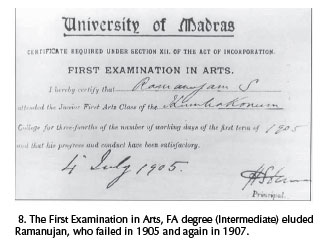 Two anecdotes have been passed on to us by his classmate, Viswanatha Iyer, and these are perhaps the only authentic ones known [4]: The first is an incident in the mathematics class, when the teacher was illustrating the division process. He said that if there were three students and he had three bananas to be distributed, then each student would get a banana. Perhaps the teacher was trying to drive home that "n divided by n is equal to one: n / n = 1". Ramanujan had a doubt and asked the teacher, "Sir, if no banana is distributed to no student, then will each student get one banana?" It is not known as to what the reaction of the teacher was. This anecdote can be interpreted, with hindsight, to reveal Ramanujan's inquisitive, intuitive nature, to realise that there could be exceptions to the division rule. Or, he might have liked the teacher to state more precisely, “n / n = 1, for all n, except for n = 0". Ramanujan told his friends, that the answer to the question of what is the value of 0 / 0 is “it may be anything. The zero of the numerator may be many times the zero of the denominator and vice versa. The value cannot be determined".
Two anecdotes have been passed on to us by his classmate, Viswanatha Iyer, and these are perhaps the only authentic ones known [4]: The first is an incident in the mathematics class, when the teacher was illustrating the division process. He said that if there were three students and he had three bananas to be distributed, then each student would get a banana. Perhaps the teacher was trying to drive home that "n divided by n is equal to one: n / n = 1". Ramanujan had a doubt and asked the teacher, "Sir, if no banana is distributed to no student, then will each student get one banana?" It is not known as to what the reaction of the teacher was. This anecdote can be interpreted, with hindsight, to reveal Ramanujan's inquisitive, intuitive nature, to realise that there could be exceptions to the division rule. Or, he might have liked the teacher to state more precisely, “n / n = 1, for all n, except for n = 0". Ramanujan told his friends, that the answer to the question of what is the value of 0 / 0 is “it may be anything. The zero of the numerator may be many times the zero of the denominator and vice versa. The value cannot be determined".
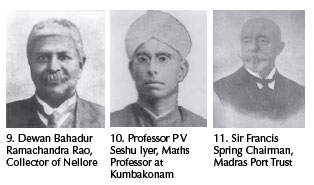 The second anecdote, in 1902, is passed on to us by Rajagopalachari [4], a schoolmate of Ramanujan: One day, during the lunch interval, he told his friend Rajagopalan (in Form VI) that Ramanujan, a Form IV student, was a "Great mathematician". Not convinced of this observation, as a test and a teaser, Rajagopalan gave in writing, on a piece of paper the following two simultaneous equations in two variables: √x + y = 7; x + √y = 11, and wondered whether Ramanujan would be able to solve them to get the answer for x and y. This would be classified by some as “out of portion" for a Form IV student, since square roots and solving simultaneous equations were to be taught in later Forms. Given the problem, Ramanujan gave the answer: x = 9, y = 4, in a few seconds, much to the surprise of the boys around him. This was a turning point in the life of Ramanujan, for it was Rajagopalachari [4] who arranged to take Ramanujan to meet Dewan Bahadur Ramachandra Rao, then the Collector of Nellore, stationed at Tirukkoilur.
The second anecdote, in 1902, is passed on to us by Rajagopalachari [4], a schoolmate of Ramanujan: One day, during the lunch interval, he told his friend Rajagopalan (in Form VI) that Ramanujan, a Form IV student, was a "Great mathematician". Not convinced of this observation, as a test and a teaser, Rajagopalan gave in writing, on a piece of paper the following two simultaneous equations in two variables: √x + y = 7; x + √y = 11, and wondered whether Ramanujan would be able to solve them to get the answer for x and y. This would be classified by some as “out of portion" for a Form IV student, since square roots and solving simultaneous equations were to be taught in later Forms. Given the problem, Ramanujan gave the answer: x = 9, y = 4, in a few seconds, much to the surprise of the boys around him. This was a turning point in the life of Ramanujan, for it was Rajagopalachari [4] who arranged to take Ramanujan to meet Dewan Bahadur Ramachandra Rao, then the Collector of Nellore, stationed at Tirukkoilur.
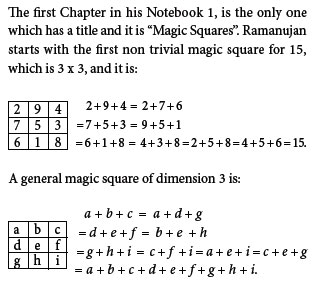 Note that in a magic square, the sum of the elements in the columns; the sum of the elements in the three rows; and the sum of the three elements along the diagonal and the skew-diagonal all add to give the number. Above, the 3 x 3 magic square is filled with the first nine natural numbers 1 to 9. The interested reader can try to form 3 x 3 magic squares for any number greater than 15 and realise that this is recreational mathematics.
Note that in a magic square, the sum of the elements in the columns; the sum of the elements in the three rows; and the sum of the three elements along the diagonal and the skew-diagonal all add to give the number. Above, the 3 x 3 magic square is filled with the first nine natural numbers 1 to 9. The interested reader can try to form 3 x 3 magic squares for any number greater than 15 and realise that this is recreational mathematics.
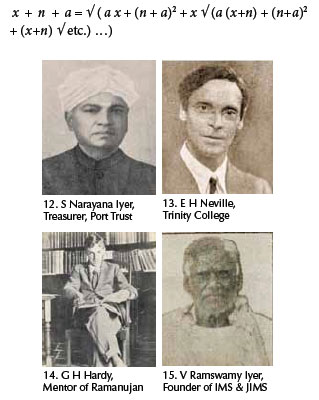 Interested students should see what the results are when he puts: x = 2, n = 1, a = 0 and x = 2, n = 1, a = 1. The resulting nested root expansions for 3 and 4, are 2 of the elementary results of Ramanujan, which he first published as Q.289 in the Journal of the Indian Mathematical Society (JIMS), which was started by V Ramaswamy Iyer, who also was the founder of the Indian Mathematical Society (1909). Ramanujan also provided the solutions in the JIMS.
Interested students should see what the results are when he puts: x = 2, n = 1, a = 0 and x = 2, n = 1, a = 1. The resulting nested root expansions for 3 and 4, are 2 of the elementary results of Ramanujan, which he first published as Q.289 in the Journal of the Indian Mathematical Society (JIMS), which was started by V Ramaswamy Iyer, who also was the founder of the Indian Mathematical Society (1909). Ramanujan also provided the solutions in the JIMS.
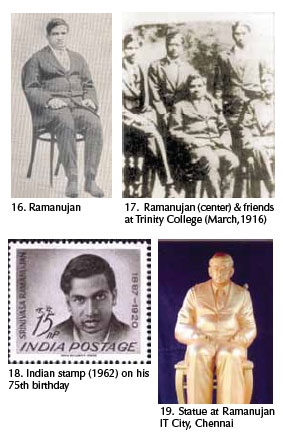 Ramanujan published 39 papers in all, of which 5 were in collaboration with Hardy. He also proposed 59 Questions and/or Answers to Questions in the JIMS, during his short life span of 32 years, 4 months and 4 days, including the famous Rogers-Ramanujan identities published by Rogers in 1909 and contained in the undated Notebook Entries of Ramanujan, which led Hardy to refer to these as Rogers-Ramanujan identities. R J Baxter (like L J Rogers and I Schur) discovered and proved the Rogers-Ramanujan identities independently and his work led to their generalisations and applications in Statistical Mechanics, in 1984, and to the solution of the 2-dimensional Hard Hexagon Model. He will continue to be talked about in this millennium for his seminal contributions to several branches of mathematics and in particular, for his pioneering work in continued fractions, partitions, introduction in "mock" theta functions and rediscovering all that was known about hypergeometric series in Europe — his footprints in the field of mathematics.
Ramanujan published 39 papers in all, of which 5 were in collaboration with Hardy. He also proposed 59 Questions and/or Answers to Questions in the JIMS, during his short life span of 32 years, 4 months and 4 days, including the famous Rogers-Ramanujan identities published by Rogers in 1909 and contained in the undated Notebook Entries of Ramanujan, which led Hardy to refer to these as Rogers-Ramanujan identities. R J Baxter (like L J Rogers and I Schur) discovered and proved the Rogers-Ramanujan identities independently and his work led to their generalisations and applications in Statistical Mechanics, in 1984, and to the solution of the 2-dimensional Hard Hexagon Model. He will continue to be talked about in this millennium for his seminal contributions to several branches of mathematics and in particular, for his pioneering work in continued fractions, partitions, introduction in "mock" theta functions and rediscovering all that was known about hypergeometric series in Europe — his footprints in the field of mathematics.
 Janaki was chosen as a wife for Ramanujan, by his mother on a visit to Rajendram, Komalthammal arranged the marriage of her 22-year-old son with the 9-year-old girl herself. Janaki went through several travails but learnt suturing. With her pension earnings — from the Port Trust, Madras University and the Hinduja Foundation — she survived without her husband, who died in 1920, for 74 years. From around 1955, she fostered a young boy W Narayanan and supported him for his collegiate studies, got him a job with the State Bank of India, and conducted his marriage to Vaidehi (also a bank employee) and was a guiding spirit for them. She also fully supported her nephew, T Ramaswamy, for his collegiate studies and for his employment. She spent a large part of her later life as a philanthropist, with W Narayanan at Hanumantharayan Koil Street, Triplicane.
Janaki was chosen as a wife for Ramanujan, by his mother on a visit to Rajendram, Komalthammal arranged the marriage of her 22-year-old son with the 9-year-old girl herself. Janaki went through several travails but learnt suturing. With her pension earnings — from the Port Trust, Madras University and the Hinduja Foundation — she survived without her husband, who died in 1920, for 74 years. From around 1955, she fostered a young boy W Narayanan and supported him for his collegiate studies, got him a job with the State Bank of India, and conducted his marriage to Vaidehi (also a bank employee) and was a guiding spirit for them. She also fully supported her nephew, T Ramaswamy, for his collegiate studies and for his employment. She spent a large part of her later life as a philanthropist, with W Narayanan at Hanumantharayan Koil Street, Triplicane.